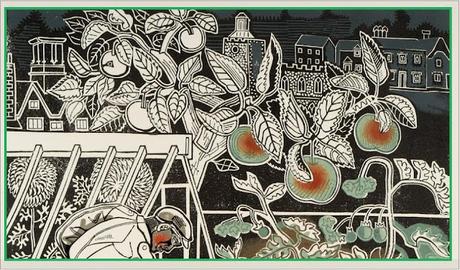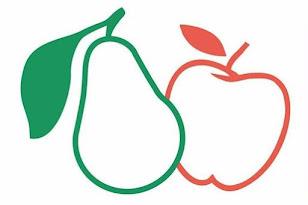I wanted to write them a poem to commemorate the event, and started off drafting a villanelle because I thought the formal structure would be appropriate to the occasion, but I soon felt constrained by that format, so let it outgrow its appointed nineteen lines and it ended up as Villanelle Overgrown. (There's a footnote on the technicalities for anyone remotely interested.)I wanted also to give it some universal as well as personal relevance, and I hope it succeeds in that. I recited it in lieu of a speech by the father of the bride and it seemed to be well-received. Fortuitously, this week's blog theme happens to be (Gar)dens, so I figured it might be all right to share it with you, given its extended metaphor.By coincidence, I've read poetry in Tower Hamlets Town Hall before, (way back in 1981 if memory serves - I was living in Bethnal Green at the time), at an event hosted by the poet Adrian Mitchell.

Autumn 1960, Edward Bawden
I figured this blog would also be a good opportunity to share an artwork (above) by a favorite British artist, as it also fits the given theme. Here then, dedicated one more time with love to Lucy and Christopher, is their wedding poem:Villanelle Overgrown
Is it a garden, though? A metaphor
worked to good effect since Arcadian days,
when husbandry was strong and wifery
unschooled, has changed co-ordinates,
transformed its landscape in subtle ways.
Is it a garden, though? We’re met here for
the intertwining of this couple’s fates,
as pairs have done with loving gaze
since husbandry was long and wifery
untooled, unphased by all that lies in wait,
happy to intone those ritual wedding lays.
Is it a garden, though? Not an allotment
nor a flinty field behind entrapping gates,
after we broke the manacle ‘obeys’
when husbandry was wrong and wifery
unfooled, established marriage emancipates.
The more it evolves, the more resolute it stays.
Is it a garden, though? Beyond the honeyed wall
is husbandry a living art? And modern wifery,
does it thrive still behind creosoted picket fences
and those sparrow-filled suburban privet thickets,
or where window-boxes brighten high-rise flats,
out in the tidy yards of red-brick terraced houses
and in cottages with honeysuckle round the door?
It was always half-jokingly said ‘to the husband
the potting-shed, to the wife the herbal beds’ but
where she can mow the lawn as well as he and he
can pick and trim the salad greens as well as she,
then notwithstanding Eden (we know that story),
the metaphor still serves for marriage as a garden
whose happy aspect, fertile loam, when tended to
with love, will yield up bounteous lives botanical,
an arbour filled with ardour, a nursery of joys, atharvesting, a mellow fruitfulness that never cloys.

* Footnote: A villanelle is a 19-line poem consisting of five tercets and a quatrain, in which line 1 (the first refrain) repeats at lines 6, 12 and 18; line 3 (the second refrain) repeats at lines 9, 15 and 19; lines 2, 5, 8, 11, 14, and 17 share an end rhyme; and lines 4, 7, 10, 13 and 16 share another end rhyme. When I found the form too constricting (in structure and length) for what I wanted to say, I let it break free from line 19 onwards, as befits the garden plot.Thanks for reading, S ;-) Email ThisBlogThis!Share to TwitterShare to Facebook
